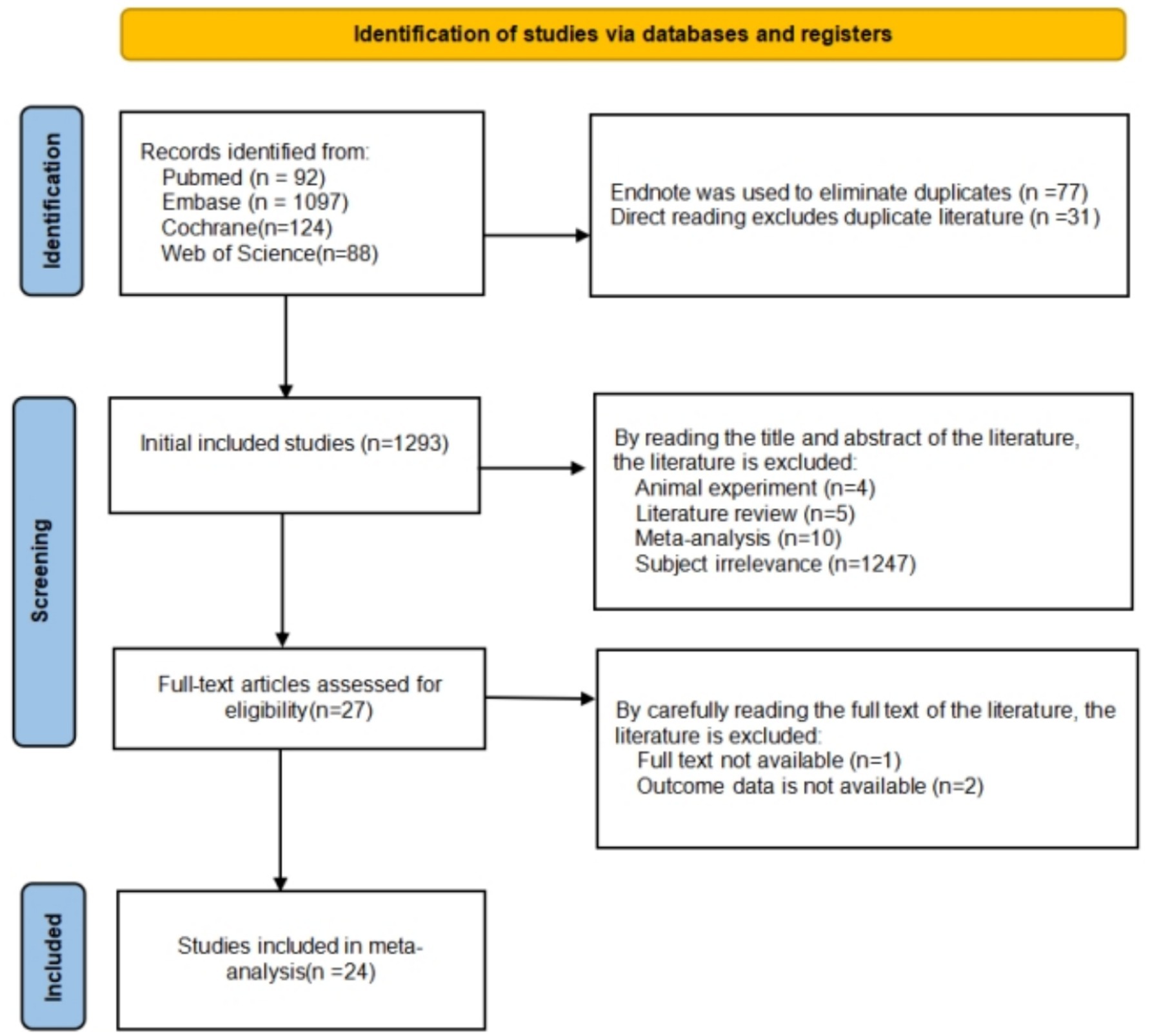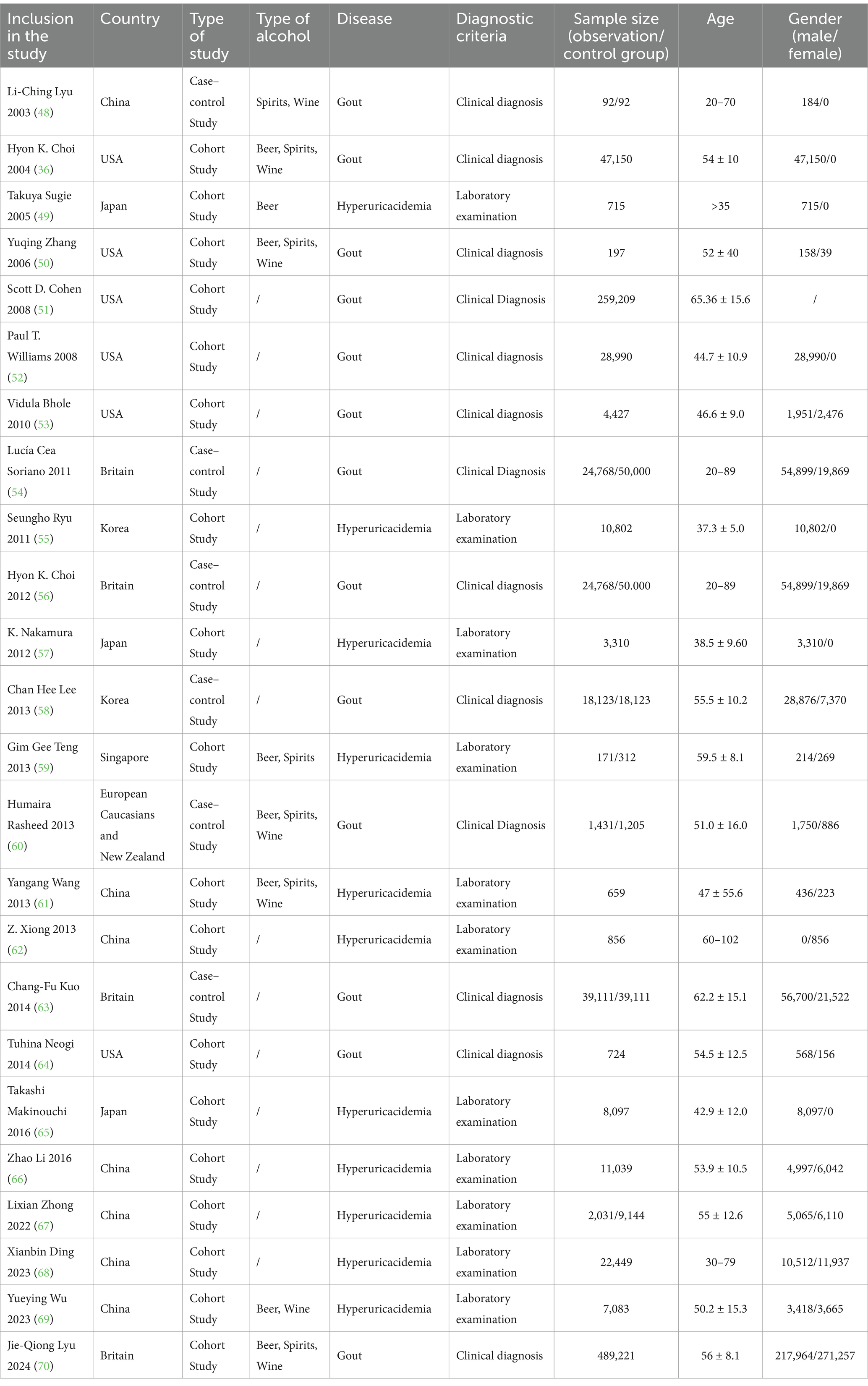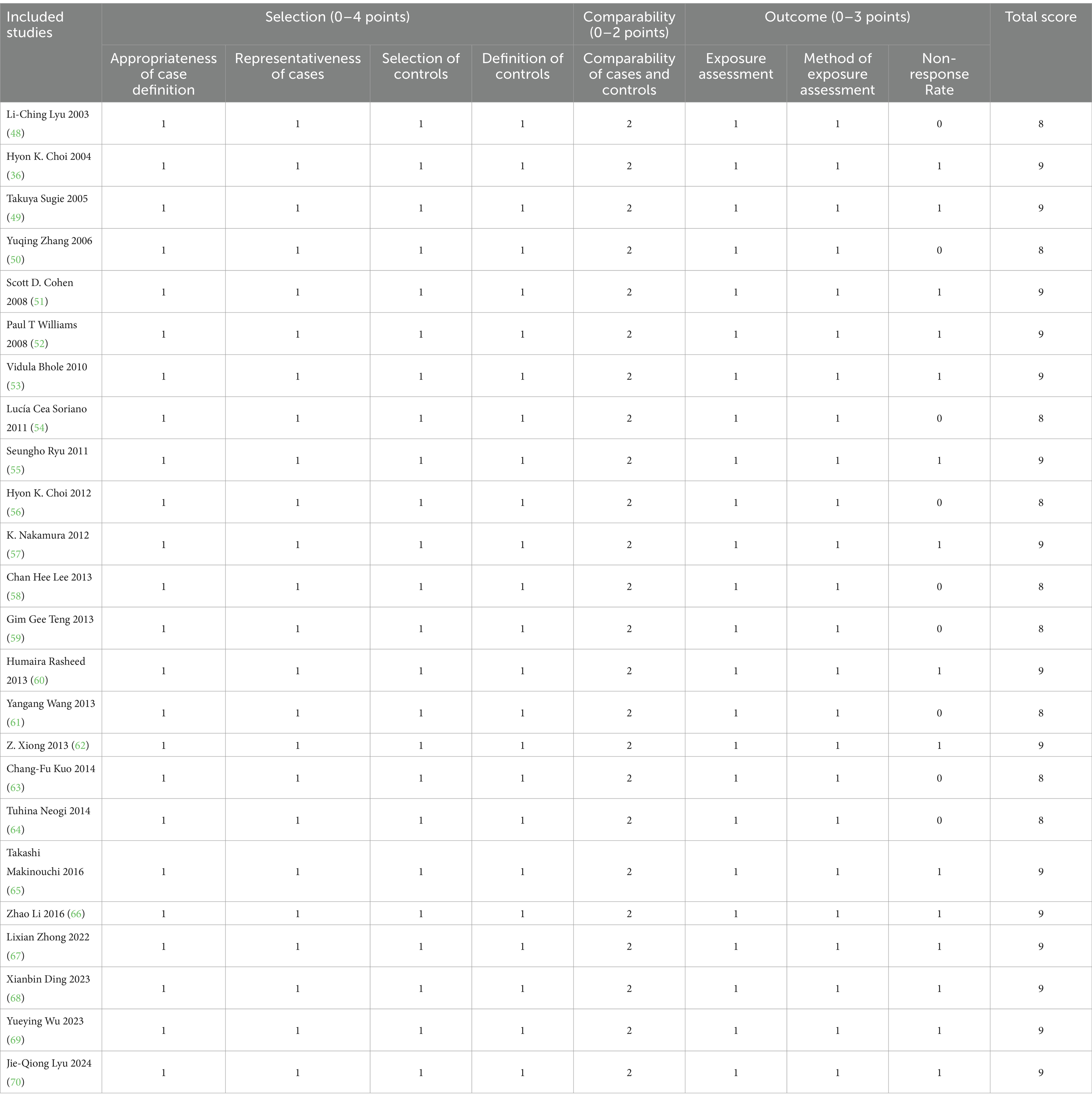- 1Jiangxi University of Chinese Medicine, Nanchang, China
- 2Dongzhimen Hospital, Beijing University of Chinese Medicine, Beijing, China
- 3Guang’anmen Hospital, China Academy of Chinese Medical Sciences, Beijing, China
- 4Hospital Affiliated to Jiangxi University of Chinese Medicine, Nanchang, China
Objective: With the rapid development of socio-economic conditions, the prevalence of hyperuricemia and gout has steadily increased, significantly impacting individuals’ quality of life. Among various dietary factors, alcohol consumption plays a crucial role in the onset and progression of these conditions. Despite its importance, systematic evaluations of the impact of alcohol consumption on hyperuricemia and gout remain limited. Therefore, this study conducts a meta-analysis to explore these effects, with a focus on the moderating roles of drinking frequency, gender, and other relevant factors.
Methods: A comprehensive literature search was performed using PubMed, Embase, Cochrane, and Web of Science databases up to November 2024. Studies assessing the relationship between alcohol consumption and hyperuricemia or gout were rigorously screened and subjected to quality evaluation. Data extraction and statistical analyses were conducted using STATA 16.0 software. A dose–response analysis was performed to assess the relationship between drinking frequency and disease risk. Regression analysis explored the potential effects of gender, age, country, study type, type of alcohol, and diagnostic criteria on the outcomes.
Results: The meta-analysis revealed that alcohol consumption significantly increases the risk of hyperuricemia and gout (OR = 1.69, 95% CI: 1.47–1.94; Z = 7.494, p < 0.05), indicating that drinkers have a 69% higher risk compared to non-drinkers. Egger’s test results (p = 0.317, p > 0.05) showed no significant publication bias, and sensitivity analyses confirmed the robustness of the findings after excluding individual studies. Dose–response analysis demonstrated a positive association between drinking frequency and the risk of hyperuricemia and gout. Regression analysis indicated that age, country, study type, type of alcohol, and diagnostic criteria had minimal effects on the results, while male were more vulnerable to alcohol-related hyperuricemia and gout than female.
Conclusion: The findings from this meta-analysis confirm that alcohol consumption significantly elevates the risk of hyperuricemia and gout, with higher drinking frequency linked to increased risk. Additionally, male drinkers showed a substantially higher risk compared to female drinkers. These results provide strong evidence supporting the development of public health policies aimed at preventing and controlling hyperuricemia and gout, while offering a foundation for future in-depth research.
Systematic review registration: This study has been registered in the International Prospective Register of Systematic Reviews (PROSPERO). The registration details are as follows: CRD42024361042 (https://www.crd.york.ac.uk/PROSPERO/).
1 Introduction
Hyperuricemia and gout are metabolic diseases caused by purine metabolism disorders, forming a continuous pathological process (1). Given their increasing global burden and clinical consequences, it is essential to understand their prevalence and associated health impacts. Over the past 20 years, the global incidence of gout has risen by 63.44%, and years of life lost due to the disease have increased by 51.12% (2). As of 2020, the global prevalence of gout ranges from 1% to 6.8%, with the number of cases projected to exceed 120 million by 2035. This trend makes gout one of the most common forms of inflammatory arthritis in Western countries (3). Hyperuricemia and gout result in elevated serum uric acid levels, which can lead to the deposition of urate crystals in joints, tendons, bursae, and other tissues. Such deposition may trigger acute inflammation and complications, including uric acid kidney stones (4). Furthermore, these conditions often coexist with other metabolic disorders such as metabolic syndrome, chronic kidney disease, diabetes, dyslipidemia, stroke, and cardiovascular diseases. Their presence significantly increases the risk of morbidity and mortality (5). With ongoing economic development and changes in diet and lifestyle, the prevalence of gout and hyperuricemia continues to rise, posing serious public health challenges worldwide. The multiple complications and comorbidities associated with these diseases not only impact individual health and quality of life but also place a significant burden on healthcare systems globally. This underscores the urgent need for targeted public health strategies and early intervention measures to address and manage these conditions effectively (6).
Dietary factors, particularly alcohol consumption, play a crucial role in the onset and progression of hyperuricemia and gout. Among these, alcohol has become one of the most extensively studied risk factors (7). However, the impact of different types of alcoholic beverages—such as beer, spirits, and wine—on the risk of hyperuricemia and gout attacks remains controversial. Some studies suggest that alcohol intake significantly increases the likelihood of gout flare-ups, with men appearing to be more susceptible than females (8–11). On the other hand, other researchers have questioned these findings, arguing that using non-drinkers as a reference group in previous studies may introduce reverse causality, thereby affecting both the strength and direction of the observed associations between alcohol consumption and gout risk (12). To resolve these inconsistencies, this study conducted a systematic review and meta-analysis of relevant literature, specifically examining the effects of alcohol consumption, drinking frequency, and different types of alcoholic beverages on the risk of gout attacks. The results aim to provide evidence-based recommendations for clinical gout management, ultimately supporting the advancement of precision medicine and personalized treatment approaches.
2 Materials and methods
2.1 Protocol and registration
To ensure methodological rigor and transparency, this meta-analysis followed the MOOSE (Meta-analysis of Observational Studies in Epidemiology) guidelines (13) and the PRISMA (Preferred Reporting Items for Systematic Reviews and Meta-Analyses) declaration (14). These frameworks provide standardized methodologies for conducting and reporting systematic reviews and meta-analyses. Furthermore, to enhance research transparency and minimize the risk of bias, the study protocol was registered with PROSPERO (CRD42024361042), an international database for systematic review protocols.
2.2 Literature search strategy
To ensure comprehensive literature coverage, we searched four major databases: PubMed, Embase, Cochrane, and Web of Science, focusing on studies examining the association between alcohol consumption and hyperuricemia or gout from the establishment of these databases to November 2024. Search terms included alcohol-related keywords such as “Alcohol Drinking” “Ethanol” “Alcohol Consumption” “Alcohol Intake” “Beer” “Wine” and “Spirits” as well as disease-related terms like “Hyperuricemia” “Uric Acid” “Gout” “Gouty Arthriti” “Uarthritis” “Arthrolithiasis” “Podagra” and “Metabolic Arthritis.” This systematic search strategy was designed to ensure broad inclusion of relevant literature, thereby enhancing the reliability and comprehensiveness of the study findings.
2.3 Inclusion criteria
To evaluate the association between alcohol consumption and hyperuricemia or gout, eligible studies must involve either individuals diagnosed with hyperuricemia or gout, or general populations with clearly measured uric acid levels. Additionally, studies are required to report the association using multivariable-adjusted statistical measures, such as relative risk (RR), odds ratio (OR), hazard ratio (HR), along with 95% confidence intervals (CI). While no restrictions are initially placed on study design, to ensure scientific rigor and comparability, only cohort studies, case–control studies, or cross-sectional studies are considered suitable for inclusion.
2.4 Excluded criteria
The exclusion criteria for literature screening were defined across four categories. First, in terms of study populations, studies were excluded if they involved non-hyperuricemia or non-gout individuals, non-human subjects, or patients with known genetic disorders of purine metabolism. Second, regarding methodological considerations, studies with inappropriate designs were excluded, including reviews, case reports, survey analyses, conference abstracts, animal experiments, in vitro studies, expert opinions, or those deemed to have low methodological quality. Third, studies with data-related issues were excluded, such as those lacking available data, providing insufficient information for meta-analysis, or missing essential diagnostic indicators (e.g., uric acid levels or gout events). Finally, duplicate publications and studies focusing solely on non-clinically relevant outcomes, such as quality of life, were also considered ineligible for inclusion.
2.5 Literature screening and data extraction
Two reviewers (Ma and Ye) independently screened the titles, abstracts, and full texts of the retrieved articles from each database based on predefined eligibility criteria. In case of discrepancies, the original articles were re-evaluated, and disagreements were resolved through discussion to reach consensus. Subsequently, relevant data were extracted from the included studies, including the author, publication year, country, study design, type of alcohol, disease type, diagnostic criteria, sample size, age, and gender. These data were then organized into a standardized three-line table to facilitate systematic analysis of study characteristics.
2.6 Literature quality assessment
According to the recommendations of the Agency for Healthcare Research and Quality (AHRQ) for evaluating observational studies, the Newcastle-Ottawa Scale (NOS) was adopted to assess the quality of case–control studies (15). Two reviewers independently evaluated each study using eight specific criteria: appropriateness of case definition, representativeness of cases, selection and definition of controls, comparability between cases and controls, determination of exposure, assessment methods, and non-response rate. Based on the total NOS scores, studies were categorized as low (1–3), moderate (4–6), or high quality (7–9). In addition, each individual item was rated as having low risk, high risk, or unclear risk of bias. Any discrepancies between the reviewers were resolved through discussion to ensure consistent and accurate quality assessments.
2.7 Statistical analysis
The extracted data were subjected to meta-analysis using STATA 16.0 software, following a systematic process. First, the odds ratio (OR) was selected as the effect size indicator, and its 95% confidence interval (CI) was calculated to determine statistical significance. Heterogeneity among studies was assessed using the p-value and I2 statistic. A fixed-effect model (FE) was applied when p > 0.1 and I2 ≤ 50%, indicating low heterogeneity. In contrast, a random-effects model (RE) was used when p ≤ 0.1 and I2 > 50%, indicating high heterogeneity (16). To assess publication bias, funnel plots were generated, and Egger’s test was performed to identify potential bias in studies on alcohol consumption and hyperuricemia or gout (17). Sensitivity analysis was conducted using the leave-one-out method to evaluate the robustness of the results and ensure the reliability of the conclusions (18). Finally, meta-regression and subgroup analyses were performed to explore potential sources of heterogeneity and examine their influence on study outcomes, thereby improving the accuracy and scientific validity of the meta-analysis (19).
To determine the dose–response relationship between alcohol consumption and hyperuricemia or gout, methods proposed by Greenland and Longnecker (20) and further developed by Orsini et al. (21) were employed. This approach requires data from at least three quantitative exposure categories, including the total number of participants, person-years, or cases, as well as the corresponding odds ratio (OR) estimates and their variances. For each included study, the median or mean level of alcohol consumption for each category was assigned to the corresponding risk estimate. In instances where these values were not reported, the midpoint between the upper and lower boundaries of each category was used. For open-ended categories (e.g., ≥30 g/day), the width of the adjacent category was used to estimate the midpoint, following the method described by Zhao et al. (22). In cases where the reference group was not the lowest exposure category, relative risk estimates were recalculated using the method proposed by Hamling et al. (23) to ensure consistency across studies. To maintain the integrity of the dose–response analysis, only studies with adequate quantitative information for dose assignment and risk estimation were included. Studies lacking specific data on alcohol intake levels or the number of cases per exposure category were excluded from this portion of the analysis, in line with established research practices (24). To investigate potential non-linear associations between alcohol consumption and the incidence of hyperuricemia or gout, restricted cubic spline modeling was conducted using three knots placed at the 25th, 50th, and 75th percentiles of alcohol intake distribution. The p-value for non-linearity was derived by testing the null hypothesis that the coefficient of the second spline was equal to zero.
All statistical analyses were performed using STATA v11.0 software (STATACorp, College Station, TX, United States), with two-sided p-values <0.05 considered statistically significant.
3 Research results
3.1 Results of literature search
A total of 1,401 articles were initially retrieved. After removing duplicates, 1,293 unique records remained and were systematically screened based on strict eligibility criteria, including study design, participant characteristics, and outcome relevance. After reviewing the titles, abstracts, and full texts, 24 studies were ultimately included in the meta-analysis, providing a robust data foundation for subsequent analyses (as shown in Figure 1).
3.2 Results of included study characteristics
The 24 studies included in this research were published between 2003 and 2024, encompassing a total of 1,173,410 participants. Geographically, 7 studies were conducted in China, 6 in the United States, 4 in the United Kingdom, 3 in Japan, 2 in South Korea, 1 in Singapore, and 1 study included populations from both European Caucasians and New Zealand. Regarding study design, 18 were cohort studies and 6 were case–control studies. Among them, 9 studies provided detailed classifications of alcohol types (e.g., beer, spirits, and wine). A total of 11 studies investigated the association between alcohol consumption and laboratory-diagnosed hyperuricemia, while 13 studies focused on clinically diagnosed gout. The age of participants ranged from 20 to 89 years. One study did not report gender information, whereas the remaining 23 studies included 541,655 male and 372,546 female participants. Detailed study characteristics are summarized in Table 1.
3.3 Results of literature quality evaluation
The quality of the 24 included studies was assessed using the Newcastle-Ottawa Scale (NOS), which evaluates methodological rigor based on three domains: selection of study groups, comparability of groups, and ascertainment of outcomes. All studies scored between 8 and 9 points, indicating consistently high methodological quality. These results reflect the strong scientific rigor and reliability of the included studies, providing a robust foundation for the meta-analysis (see Table 2).
3.4 Results of meta-analysis
3.4.1 Relationship between alcohol consumption and hyperuricacidemia/gout
This meta-analysis included 24 studies examining the association between alcohol consumption and hyperuricemia or gout. Heterogeneity testing revealed significant variability among studies (p < 0.05, I2 = 94.8%), warranting the use of a random-effects model for pooled effect estimation. The results showed that alcohol consumption was significantly associated with an increased risk of hyperuricemia or gout, with a combined OR of 1.69 (95% CI: 1.47–1.94; Z = 7.494, p < 0.05), indicating a 69% higher risk in alcohol consumers compared to non-drinkers (Figure 2A). Publication bias was evaluated using a funnel plot and Egger’s test. The scatter points in the funnel plot were symmetrically distributed, with only a few studies falling outside the 95% confidence limits. Egger’s test yielded a p-value of 0.317 (p > 0.05), suggesting no significant publication bias (Figures 2B,C). Furthermore, sensitivity analysis was performed using the leave-one-out approach. The pooled OR remained stable throughout, indicating that the overall results were robust and reliable (Figure 2D).
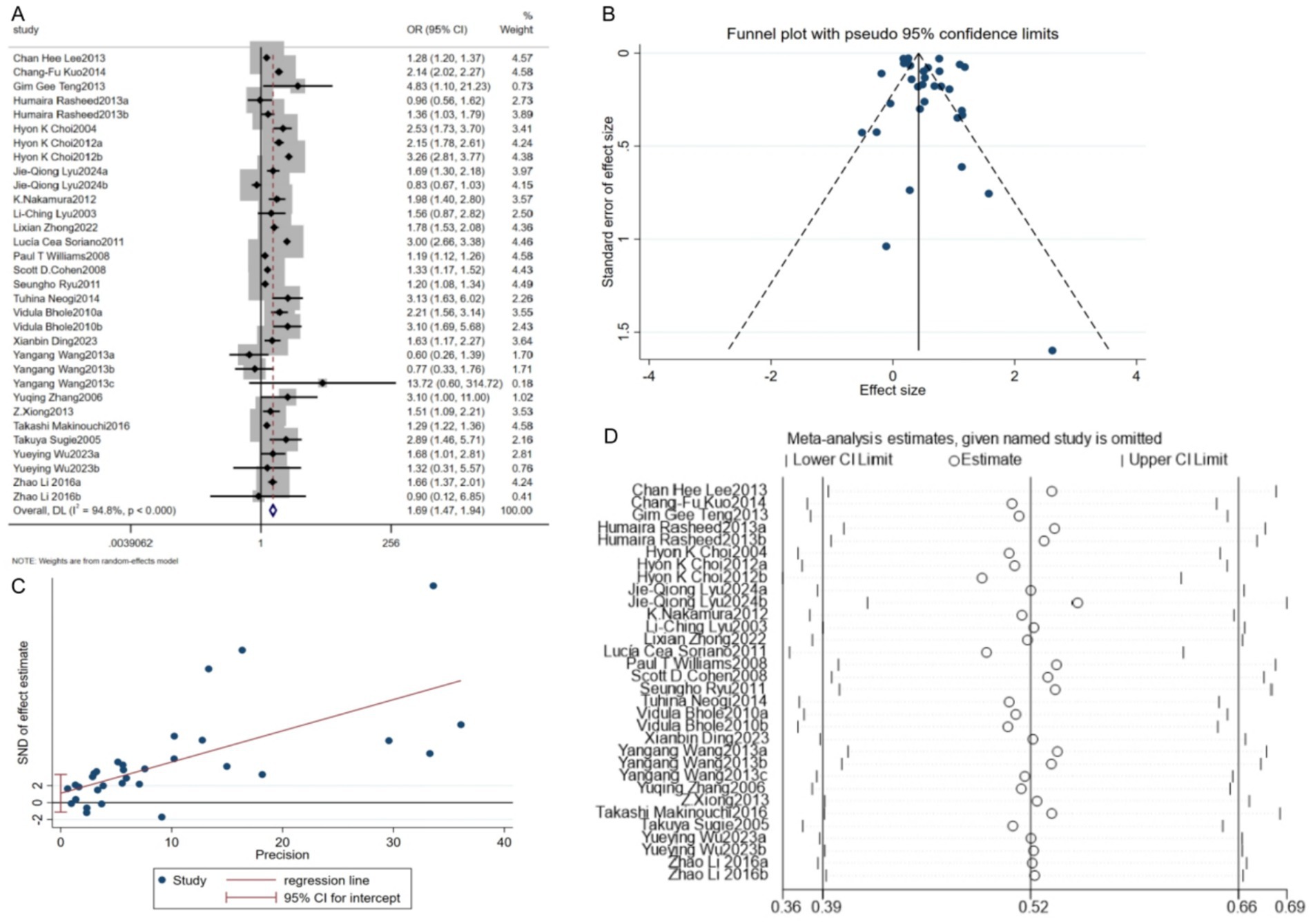
Figure 2. Relationship between alcohol consumption and hyperuricacidemia/gout. (A) Forest plot; (B) Funnel plot; (C) Egger’s test; (D) Sensitivity analysis.
Eleven studies investigated the association between alcohol consumption and hyperuricemia. The heterogeneity test showed significant heterogeneity (p < 0.001, I2 = 69.8%), so a random-effects model was used for effect size aggregation analysis. The meta-analysis results indicated that alcohol consumption significantly increases the risk of hyperuricemia [OR = 1.51, 95% CI (1.32, 1.74), Z = 5.886, p < 0.001] (Figure 3A). Regarding publication bias, the funnel plot showed slight asymmetry with more scattered points on the right side, and some studies were located outside the lower boundary. However, the Egger test (p = 0.123) did not reach statistical significance, indicating no significant publication bias risk was observed (Figures 3B,C). Sensitivity analysis showed that after excluding each study one by one, the pooled effect size did not change significantly, suggesting that the results are robust and reliable (Figure 3D).
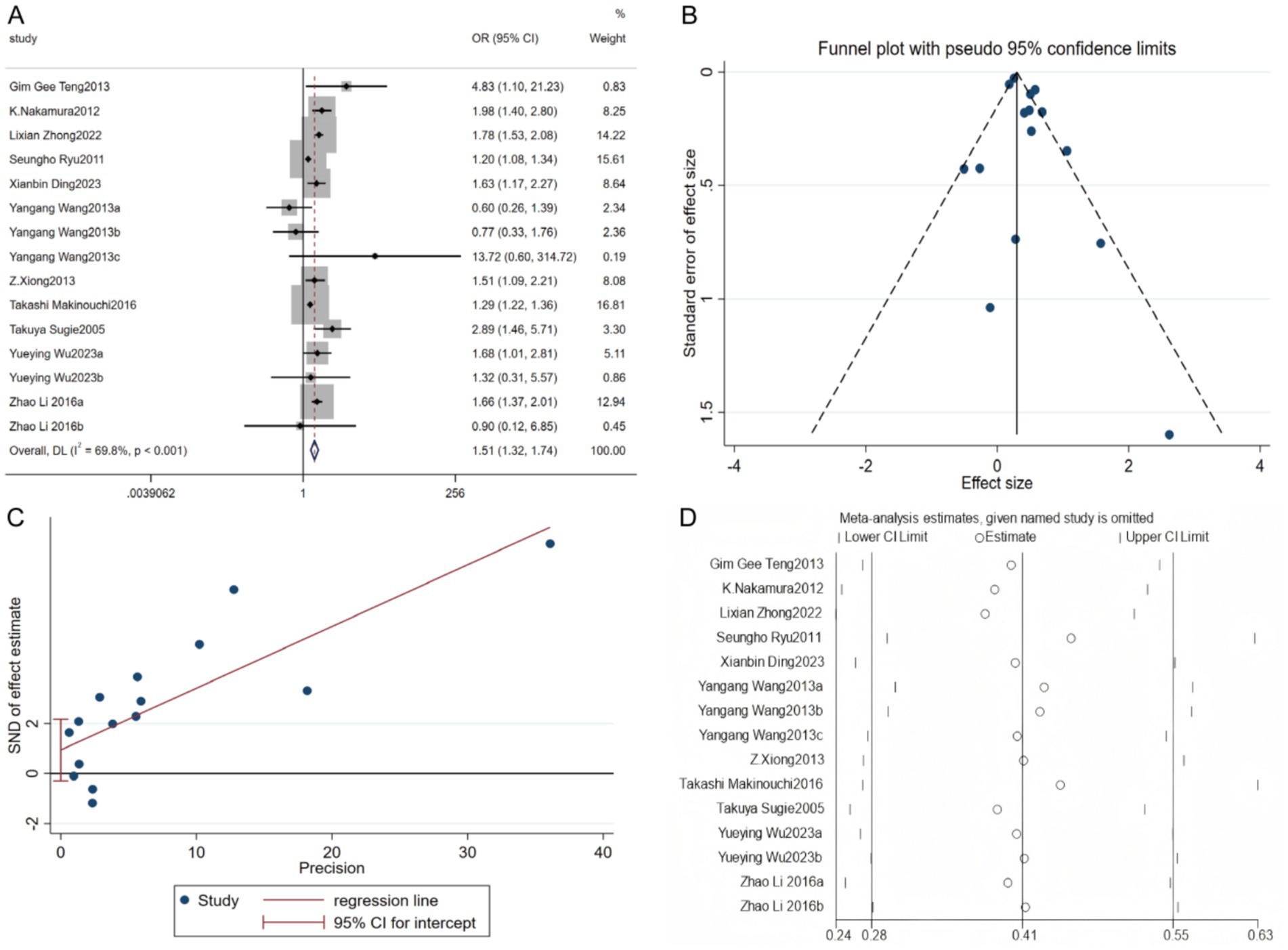
Figure 3. Relationship between alcohol consumption and hyperuricacidemia. (A) Forest plot; (B) Funnel plot; (C) Egger’s test; (D) Sensitivity analysis.
Twelve studies analyzed the relationship between alcohol consumption and gout. The heterogeneity analysis showed significant differences (p < 0.001, I2 = 96.8%), so a random-effects model was used for the pooled analysis. The results showed that alcohol consumption significantly increases the risk of gout [OR = 1.81, 95% CI (1.48, 2.21), Z = 5.777, p < 0.001] (Figure 4A). The funnel plot showed that the study scatter was generally symmetric, with only a few studies outside the confidence interval. The Egger test result (p = 0.481) indicated no significant publication bias (Figures 4B,C). Sensitivity analysis results were stable, and excluding each study one by one showed minimal changes in the effect size, indicating that the meta-analysis conclusion has good robustness and credibility (Figure 4D).
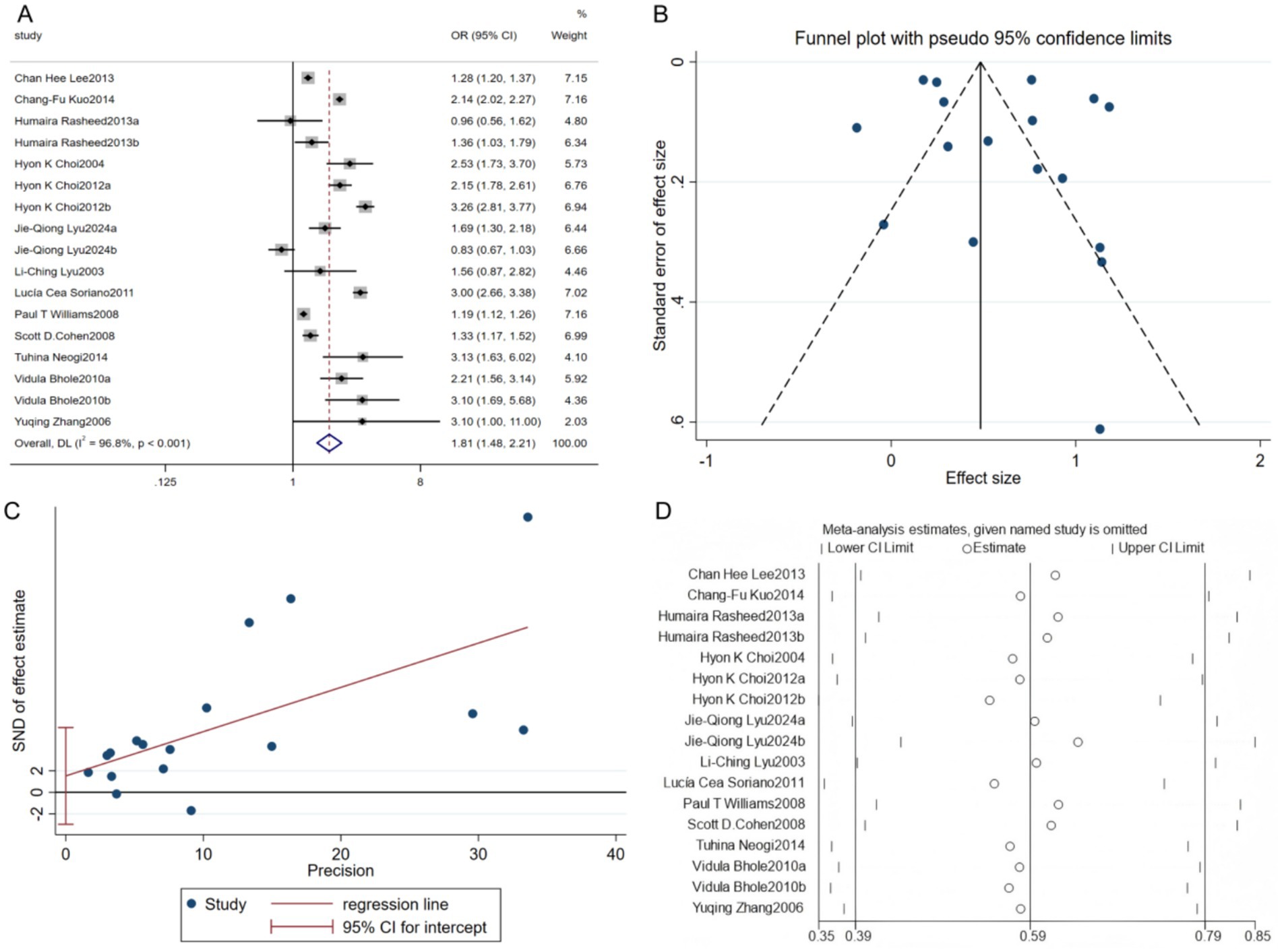
Figure 4. Relationship between alcohol consumption and gout. (A) Forest plot; (B) Funnel plot; (C) Egger’s test; (D) Sensitivity analysis.
For the nonlinear dose–response analysis, at least three exposure categories were required; thus, studies that only provided continuous estimates or lacked case and participant numbers per category were excluded, resulting in 10 eligible studies. No evidence of a nonlinear association was observed between alcohol consumption frequency and the risk of hyperuricemia or gout (p for nonlinearity = 0.6979). Therefore, a restricted cubic spline model was applied to assess the linear dose–response relationship. The analysis revealed a significant positive linear association, indicating that higher frequencies of alcohol consumption were consistently associated with an increased risk of hyperuricemia or gout (Figure 5).
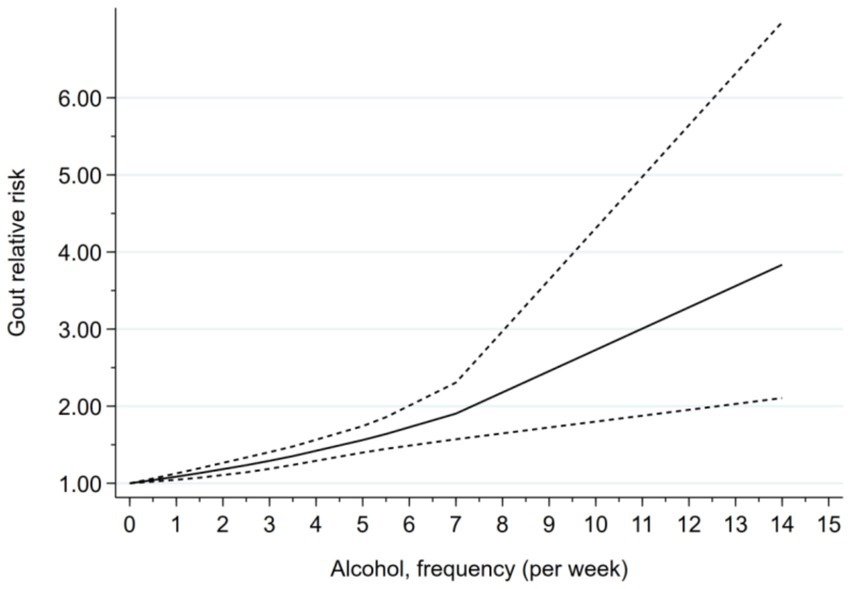
Figure 5. Dose-response analysis of the relationship between alcohol consumption frequency and hyperuricacidemia/gout.
3.4.2 Subgroups
To comprehensively assess the potential association between alcohol consumption and hyperuricemia/gout, a subgroup analysis was conducted based on different countries, study types, alcohol types, diagnostic criteria, age, and gender. This analysis helps identify potential influences of various variables and sources of heterogeneity in the study results. The results are shown in Figure 6. The following sections provide a detailed discussion based on these subgroup factors. First, at the country level, significant heterogeneity differences were observed among different countries. South Korea (I2 = 0.0%) and China (I2 = 18.2%) exhibited low heterogeneity, while America (I2 = 86.7%), Japan (I2 = 81.7%), Singapore (I2 = 100.0%), and Britain (I2 = 96.3%) showed high heterogeneity, prompting the use of a random-effects model. Significant associations between alcohol consumption and hyperuricemia/gout were observed across all countries. The specific results are as follows: South Korea (OR = 1.26, 95% CI: 1.05–1.51, Z = 7.958, p < 0.05); Britain (OR = 1.90, 95% CI: 1.55–2.34, Z = 4.823, p < 0.05); Japan (OR = 1.78, 95% CI: 1.44–2.20, Z = 2.567, p = 0.01); Singapore (OR = 4.83, 95% CI: 1.10–21.22,Z = 2.085, p = 0.037); China (OR = 1.60, 95% CI: 1.40–1.83, Z = 6.840, p < 0.05), as shown in Supplementary Figure 1. These findings suggest that geographic differences significantly influence the observed associations. Given the country-specific differences, the study further explored heterogeneity by examining different study types. Both case–control studies (I2 = 97.4%) and cohort studies (I2 = 80.1%) exhibited high heterogeneity, potentially due to differences in study design, sample selection, and follow-up duration. Nevertheless, alcohol consumption significantly increased the risk of hyperuricemia/gout in both case–control studies (OR = 1.88, 95%CI: 1.42–2.50, Z = 4.366, p < 0.05) and cohort studies (OR = 1.53, 95%CI: 1.38–1.71, Z = 7.675, p < 0.05), as detailed in Supplementary Figure 2. Study design differences may interact with specific alcohol types, prompting further exploration. Regarding alcohol types, beer (OR = 1.27, 95%CI: 1.07–1.51, Z = 2.737, p = 0.006, I2 = 70.1%), spirits (OR = 1.19, 95%CI: 1.03–1.39, Z = 2.286, p = 0.022, I2 = 65%), and wine (OR = 1.11, 95%CI: 1.00–1.23, Z = 2.019, p = 0.043, I2 = 62.4%) all showed significant associations, albeit with varying effect sizes, as shown in Supplementary Figure 3. Additionally, the analysis explored different diagnostic criteria. Both clinical diagnosis (I2 = 96.8%) and laboratory-based diagnosis (I2 = 69.8%) demonstrated significant associations between alcohol consumption and hyperuricemia/gout, with OR = 1.81 (95% CI: 1.48–2.21, Z = 5.777, p < 0.05) and OR = 1.51 (95% CI: 1.32–1.74, Z = 5.886, p < 0.05), respectively, as shown in Supplementary Figure 4. Given that diagnosis can be influenced by patient age, age-specific analyses were conducted. In terms of age differences, the effects of alcohol consumption varied across age groups. Significant associations were observed among individuals with a mean age of <50 years (OR = 1.37, 95% CI: 1.20–1.56, I2 = 78.1%, Z = 4.785, p < 0.05) and ≥50 years (OR = 1.58, 95% CI: 1.32–1.90, I2 = 92.1%, Z = 5.02, p < 0.05), with older age linked to a higher risk, as shown in Supplementary Figure 5. Given potential metabolic and hormonal differences by gender, a gender-specific analysis followed. Finally, concerning gender, alcohol consumption was significantly associated with hyperuricemia/gout in males (OR = 1.59, 95% CI: 1.41–1.78, I2 = 83.2%, Z = 7.783, p < 0.05), while the association in females (OR = 1.62, 95% CI: 0.96–2.72, I2 = 77.3%, Z = 1.811, p = 0.07) did not reach statistical significance. This suggests that gender differences may influence the alcohol-disease relationship, with men being particularly at risk, as detailed in Supplementary Figure 6.
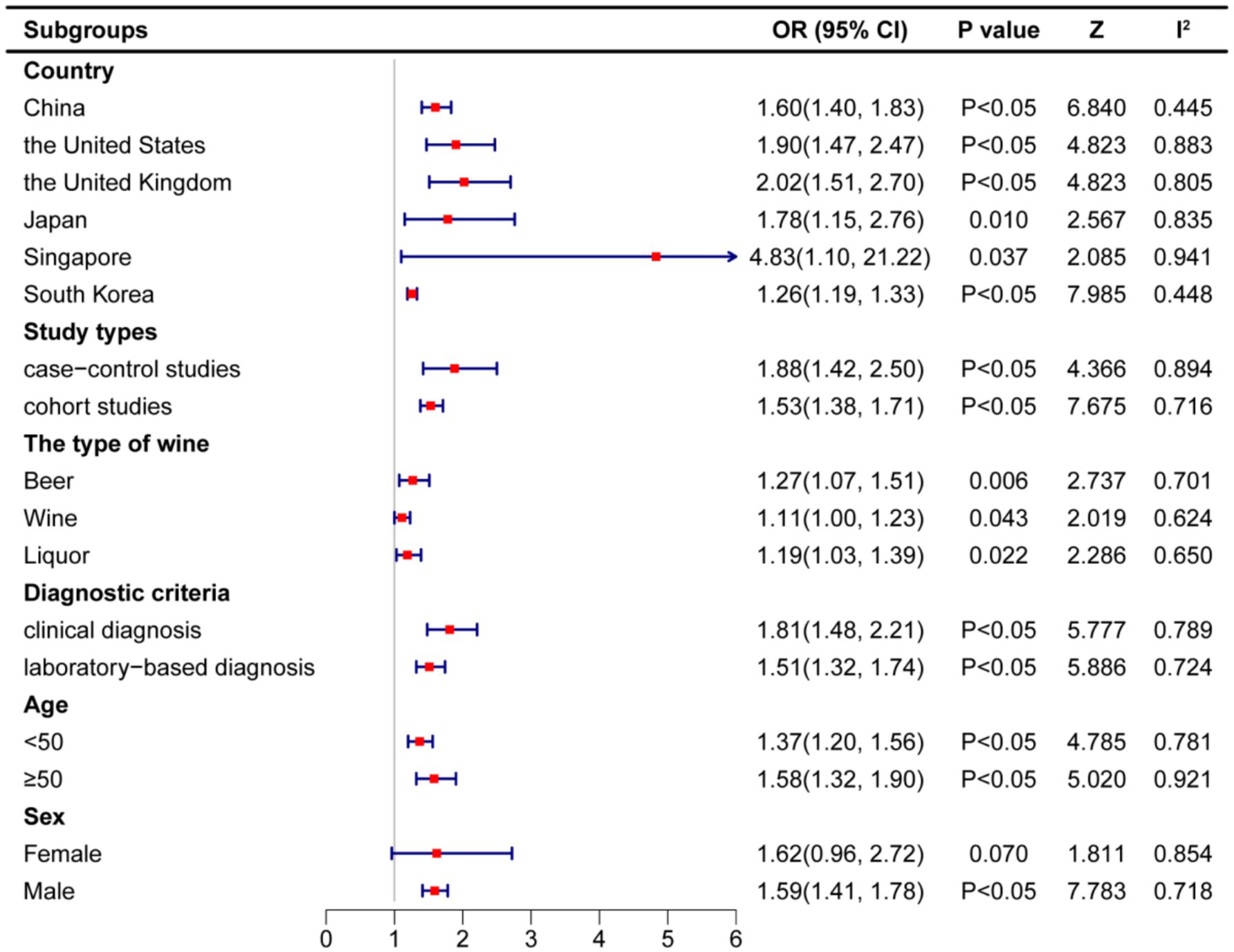
Figure 6. Subgroup analysis of the relationship between alcohol consumption and hyperuricacidemia/gout—forest plot.
4 Discussion
This systematic review and meta-analysis aimed to systematically assess the association between alcohol consumption and the risk of hyperuricemia and gout, including 24 studies that met the inclusion criteria. The pooled analysis revealed a statistically significant positive correlation between alcohol consumption and the risk of developing hyperuricemia and gout. Further dose–response analysis indicated a nonlinear relationship between alcohol intake and the risk of these diseases, suggesting that as drinking frequency and intake increase, the disease risk also tends to rise, implying a potential cumulative promotive effect of alcohol consumption in disease onset. To assess the robustness of this association and its applicability across different populations, subgroup analyses were conducted. The results showed no significant differences in the observed associations across study regions, study design types, types of alcohol consumed, age groups of participants, and diagnostic criteria for hyperuricemia/gout, indicating a certain degree of generalizability of the findings. However, the gender subgroup analysis revealed that the increased risk was primarily observed in the male population, and the effect of alcohol consumption on hyperuricemia and gout risk in females did not reach statistical significance. Based on the above findings, this study provides reliable evidence for formulating dietary intervention strategies, optimizing nutritional guidelines, and advancing preventive efforts for hyperuricemia and gout.
In recent years, with continuous improvements in living standards and changes in lifestyle, hyperuricemia and gout have gradually become common diseases, closely related to factors such as age, gender, and lifestyle (25). Among these, hyperuricemia is widely considered the pathological basis of gout. Elevated levels of serum uric acid can result in the formation and deposition of monosodium urate crystals in joints and soft tissues, ultimately triggering acute inflammatory responses and joint pain characteristic of gout (26). Although approximately 85–90% of patients with hyperuricemia do not exhibit overt symptoms or experience gout attacks (27), clinical imaging studies have demonstrated that about 30–50% of asymptomatic hyperuricemic individuals show urate crystal deposits in joints or tendons, suggesting a potential predisposition to gout attacks in this population (28, 29). Against this background, the findings of the present study further confirm a significant positive correlation between alcohol consumption and the risk of hyperuricemia and gout, consistent with previous research (30). To further explore the role of alcohol consumption in the pathogenesis of hyperuricemia and gout, several studies have proposed physiological and pathological hypotheses. Firstly, alcoholic beverages—especially beer and spirits—contain high concentrations of purines, whose metabolic byproducts can markedly enhance uric acid production in the body (31). Secondly, lactic acid produced during alcohol metabolism may inhibit the renal excretion of uric acid, leading to elevated serum uric acid levels (32). In addition, accumulating evidence suggests that alcohol consumption may indirectly aggravate uric acid metabolic imbalance by disrupting the gut microbiota (33). Dysbiosis of the gut flora can affect both the synthesis and excretion of uric acid, thereby increasing the risk of hyperuricemia and gout (33). Finally, alcohol may interfere with the kidney’s regulatory mechanisms for uric acid, affecting its filtration, reabsorption, and secretion in the renal tubules, thus further disrupting uric acid homeostasis in the body (34).
Subgroup analysis revealed a significant gender difference in the impact of alcohol consumption on the risk of hyperuricemia and gout, with males being more susceptible to alcohol-related metabolic risks than females. This finding is largely consistent with previous research. One study indicated that hypertension and alcohol consumption are the main risk factors for hyperuricemia and gout in men, whereas smoking shows a stronger risk association among women (35). These findings suggest that gender may play a moderating role in the causal pathway between alcohol intake and hyperuricemia/gout. The potential mechanisms underlying this gender difference may involve both physiological foundations and behavioral patterns. In terms of biological mechanisms, differences in sex hormone levels may play a crucial role. Studies have shown that estrogen can enhance the renal excretion of uric acid, thereby reducing serum uric acid levels and lowering the risk of gout in women (36, 37). However, in postmenopausal women, the abrupt decline in estrogen levels may lead to elevated serum uric acid concentrations, consequently increasing the likelihood of gout onset (38). Moreover, baseline differences in serum uric acid levels between sexes should not be overlooked, as men generally exhibit higher serum uric acid concentrations and are thus more sensitive to alcohol-induced metabolic disturbances (35). From a behavioral perspective, gender differences in drinking patterns may further amplify the impact of alcohol on disease risk. Relevant studies have demonstrated that alcohol intake is significantly higher in men than in women, particularly in terms of the frequency and quantity of beer and spirits consumption, both of which are closely associated with increased serum uric acid levels. In contrast, women are more inclined to consume wine, which has a relatively smaller impact on uric acid metabolism (39). These differences help explain the heterogeneous effects of alcohol on the risk of hyperuricemia and gout across genders.
This study further found that different types of alcoholic beverages exert significantly different effects on the risk of hyperuricemia and gout, with beer associated with the highest risk, followed by spirits, while wine showed relatively lower impact. This conclusion is consistent with findings from previous studies (40). Notably, the influence of beer on hyperuricemia and gout may operate through multiple mechanisms. On one hand, beer is rich in D-amino acids, which can be metabolized into uric acid through specific pathways in the body, thereby increasing endogenous uric acid production (41). On the other hand, ethanol in beer may inhibit the function of urate transporters in the kidney, reducing the efficiency of uric acid excretion and leading to uric acid retention (42). This dual mechanism of “increased production and decreased excretion” may be the primary reason why beer significantly elevates disease risk. Although spirits contain lower levels of purines compared to beer, their high ethanol concentration can promote lactic acid production in the body, which in turn competitively inhibits the renal tubular excretion of uric acid, resulting in elevated serum uric acid levels (43). Therefore, despite their relatively low purine content, spirits still pose a potential risk for inducing hyperuricemia. In contrast, wine appears to have a more complex influence on uric acid metabolism. Although wine (especially red wine) contains ethanol, it is also rich in polyphenolic compounds, which are believed to exert protective effects on uric acid metabolism by reducing oxidative stress and inhibiting xanthine oxidase activity (44). However, this potential benefit is dose-dependent—if the intake exceeds a certain threshold, the harmful effects of ethanol may prevail and offset any protective benefits.
It is noteworthy that the positive correlation between alcohol consumption and the risk of hyperuricemia and gout is more pronounced in individuals over the age of 50, a phenomenon likely influenced by multiple age-related factors. Firstly, as age increases, renal function gradually declines, leading to reduced uric acid excretion and consequently elevated serum uric acid levels. Relevant studies have shown that decreased glomerular filtration rate (GFR) in the elderly is one of the key physiological contributors to the increased prevalence of hyperuricemia (45). Secondly, purine metabolism pathways also undergo age-related alterations, particularly with increased expression and activity of xanthine oxidase (XO) in older populations. XO, a rate-limiting enzyme in purine metabolism, catalyzes the conversion of hypoxanthine to xanthine and subsequently to uric acid; its elevated activity can significantly enhance uric acid production (46). Some studies suggest that this increased enzyme activity may be associated with dysregulated expression across multiple tissues. In addition, lifestyle changes among the elderly may further aggravate uric acid metabolic imbalance. For instance, reduced physical activity and increased intake of purine-rich foods are behavioral factors that can lead to increased uric acid production and impaired excretion (47). Against this backdrop, the metabolic burden induced by alcohol consumption further exacerbates hyperuricemic states, significantly increasing the risk of gout development. In summary, declining renal function, abnormal purine metabolism, and lifestyle changes synergistically amplify the pathogenic impact of alcohol consumption on hyperuricemia and gout during older age. Therefore, special attention should be given to alcohol consumption in individuals over 50 years old to reduce the risk of related metabolic disorders.
Despite employing a meta-analytic approach to systematically synthesize existing literature—thus enhancing statistical power and the robustness of results—this study has certain limitations that warrant attention. Firstly, substantial heterogeneity was observed, which may stem from differences across the included studies, such as variations in dietary patterns among populations, the alcohol content and composition of different alcoholic beverages, and participants’ lifestyles and drinking habits. These factors may lead to considerable variability in effect size estimates, thereby reducing the consistency and credibility of the study’s conclusions. Secondly, publication bias is a common issue in systematic reviews and meta-analyses. Studies with statistically significant findings are more likely to be published, whereas negative or non-significant results are often underreported, which may lead to a systematic overestimation of the effect of alcohol consumption on hyperuricemia or gout and compromise the objectivity of the findings. In addition, most of the included studies were observational in nature and are inherently susceptible to selection bias (e.g., inappropriate participant recruitment), information bias (e.g., self-reported alcohol intake), and residual confounding (e.g., insufficient control of variables such as body weight or medication use), which limit the accuracy of causal inference between alcohol consumption and hyperuricemia/gout. Furthermore, the meta-analysis results may be constrained by the timing of the literature search and publication lag, making it difficult to capture the latest research developments—especially in a rapidly evolving field—thereby diminishing the timeliness and practical applicability of the findings. Therefore, although this study provides valuable evidence-based insights into the association between alcohol consumption and hyperuricemia/gout, practical application of its findings should be guided by results from up-to-date, high-quality prospective cohort studies or randomized controlled trials to further verify and refine the conclusions, thereby enhancing their scientific validity and generalizability.
In summary, alcohol consumption is closely associated with the risk of gout and hyperuricemia, and this risk increases with the frequency and amount of alcohol consumed, particularly in the male population, where the association is more pronounced. The dose–response analysis in this study further confirms that even low levels of alcohol consumption can adversely affect disease risk, while high levels of drinking significantly exacerbate this risk. Therefore, reasonable control of drinking behavior, particularly limiting excessive alcohol intake in high-risk populations (such as middle-aged and elderly men), is of great importance for the prevention and management of gout and hyperuricemia. In clinical practice, a comprehensive approach considering individual drinking habits, gender, age, and comorbidities should be adopted to develop targeted health interventions, such as controlling alcohol consumption frequency, adjusting the types of alcoholic beverages consumed, and enhancing lifestyle management. Future research could further focus on the biological mechanisms through which alcohol triggers metabolic disturbances, including the regulation of xanthine oxidase activity, renal uric acid excretion pathways, gut microbiota dysbiosis, and systemic inflammatory responses, with the aim of providing a stronger theoretical foundation and practical guidance for the precise prevention and intervention of hyperuricemia and gout.
Data availability statement
The original contributions presented in the study are included in the article/Supplementary material, further inquiries can be directed to the corresponding author.
Author contributions
WM: Writing – original draft, Writing – review & editing. GY: Writing – original draft, Writing – review & editing. YL: Writing – original draft, Writing – review & editing. WS: Methodology, Writing – review & editing. XH: Writing – review & editing. LH: Writing – review & editing. LC: Writing – review & editing. BH: Writing – review & editing. HL: Funding acquisition, Project administration, Writing – review & editing.
Funding
The author(s) declare that financial support was received for the research and/or publication of this article. This work was supported by grants from the National Natural Science Foundation of China (82060871), Key Projects of Jiangxi Natural Science Foundation (20232ACB206051), and Jiangxi Province 2024 Science and Technology Special Funds (20243BCE51009). The funders had no role in the study design or in the collection, analysis, and interpretation of the data, writing of the report, or decision to submit the article for publication.
Conflict of interest
The authors declare that the research was conducted in the absence of any commercial or financial relationships that could be construed as a potential conflict of interest.
Generative AI statement
The authors declare that no Gen AI was used in the creation of this manuscript.
Publisher’s note
All claims expressed in this article are solely those of the authors and do not necessarily represent those of their affiliated organizations, or those of the publisher, the editors and the reviewers. Any product that may be evaluated in this article, or claim that may be made by its manufacturer, is not guaranteed or endorsed by the publisher.
Supplementary material
The Supplementary material for this article can be found online at: https://www.frontiersin.org/articles/10.3389/fnut.2025.1588980/full#supplementary-material
References
1. Dalbeth, N, Gosling, AL, Gaffo, A, and Abhishek, A. Gout. Lancet. (2021) 397:1843–55. doi: 10.1016/S0140-6736(21)00569-9
2. Li, Y, Chen, Z, Xu, B, Wu, G, Yuan, Q, Xue, X, et al. Global, regional, and national burden of gout in elderly 1990–2021: an analysis for the global burden of disease study 2021. BMC Public Health. (2024) 24:3298. doi: 10.1186/s12889-024-20799-w
3. Dehlin, M, Jacobsson, L, and Roddy, E. Global epidemiology of gout: prevalence, incidence, treatment patterns and risk factors. Nat Rev Rheumatol. (2020) 16:380–90. doi: 10.1038/s41584-020-0441-1
4. Ahmad, MI, Masood, S, Furlanetto, DM, and Nicolaou, S. Urate crystals; beyond joints. Front Med. (2021) 8:8. doi: 10.3389/fmed.2021.649505
5. Singh, JA, and Gaffo, A. Gout epidemiology and comorbidities. Semin Arthritis Rheum. (2020) 50:S11–6. doi: 10.1016/j.semarthrit.2020.04.008
6. Sandoval-Plata, G, Nakafero, G, Chakravorty, M, Morgan, K, and Abhishek, A. Association between serum urate, gout and comorbidities: a case-control study using data from the UK biobank. Rheumatology (Oxford). (2021) 60:3243–51. doi: 10.1093/rheumatology/keaa773
7. Choi, HK, and Curhan, G. Beer, liquor, and wine consumption and serum uric acid level: the third National Health and nutrition examination survey. Arthritis Rheum. (2004) 51:1023–9. doi: 10.1002/art.20821
8. Yokose, C, McCormick, N, and Choi, HK. Dietary and lifestyle-centered approach in gout care and prevention. Curr Rheumatol Rep. (2021) 23:51. doi: 10.1007/s11926-021-01020-y
9. Chuah, MH, Leask, MP, Topless, RK, Gamble, GD, Sumpter, NA, Stamp, LK, et al. Interaction of genetic variation at ADH1B and MLXIPL with alcohol consumption for elevated serum urate level and gout among people of european ethnicity. Arthritis Res Ther. (2024) 26:45. doi: 10.1186/s13075-024-03279-9
10. Thompson, MD, Wu, YY, Cooney, RV, Wilkens, LR, Haiman, CA, and Pirkle, CM. Modifiable factors and incident gout across ethnicity within a large multiethnic cohort of older adults. J Rheumatol. (2022) 49:504–12. doi: 10.3899/jrheum.210394
11. Zhang, B, Fang, W, Zeng, X, Zhang, Y, Ma, Y, Sheng, F, et al. Clinical characteristics of early- and late-onset gout: a cross-sectional observational study from a Chinese gout clinic. Medicine. (2016) 95:e5425. doi: 10.1097/MD.0000000000005425
12. Rezende, LFM, Ferrari, G, Lee, DH, Aune, D, Liao, B, Huang, W, et al. Lifestyle risk factors and all-cause and cause-specific mortality: assessing the influence of reverse causation in a prospective cohort of 457,021 US adults. Eur J Epidemiol. (2022) 37:11–23. doi: 10.1007/s10654-021-00829-2
13. Stroup, DF, Berlin, JA, Morton, SC, Olkin, I, Williamson, GD, Rennie, D, et al. Meta-analysis of observational studies in epidemiology: a proposal for reporting. JAMA. (2000) 283:2008–12. doi: 10.1001/jama.283.15.2008
14. Liberati, A, Altman, DG, Tetzlaff, J, Mulrow, C, Gotzsche, PC, Ioannidis, JPA, et al. The PRISMA statement for reporting systematic reviews and meta-analyses of studies that evaluate healthcare interventions: explanation and elaboration. BMJ. (2009) 339:b2700. doi: 10.1136/bmj.b2700
15. Stang, A. Critical evaluation of the Newcastle-Ottawa scale for the assessment of the quality of nonrandomized studies in meta-analyses. Eur J Epidemiol. (2010) 25:603–5. doi: 10.1007/s10654-010-9491-z
16. Cumpston, M, Li, T, Page, MJ, Chandler, J, Welch, VA, Higgins, JPT, et al. Updated guidance for trusted systematic reviews: a new edition of the cochrane handbook for systematic reviews of interventions. Cochrane Database Syst Rev. (2019) 2019:ED000142. doi: 10.1002/14651858.ED000142
17. Harbord, RM, Egger, M, and Sterne, JAC. A modified test for small-study effects in meta-analyses of controlled trials with binary endpoints. Stat Med. (2006) 25:3443–57. doi: 10.1002/sim.2380
18. Anzures-Cabrera, J, and Higgins, JPT. Graphical displays for meta-analysis: an overview with suggestions for practice. Res Synth Methods. (2010) 1:66–80. doi: 10.1002/jrsm.6
19. Tipton, E, Pustejovsky, JE, and Ahmadi, H. A history of meta-regression: technical, conceptual, and practical developments between 1974 and 2018. Res Synth Methods. (2019) 10:161–79. doi: 10.1002/jrsm.1338
20. Greenland, S, and Longnecker, MP. Methods for trend estimation from summarized dose-response data, with applications to meta-analysis. Am J Epidemiol. (1992) 135:1301–9. doi: 10.1093/oxfordjournals.aje.a116237
21. Orsini, N, Li, R, Wolk, A, Khudyakov, P, and Spiegelman, D. Meta-analysis for linear and nonlinear dose-response relations: examples, an evaluation of approximations, and software. Am J Epidemiol. (2012) 175:66–73. doi: 10.1093/aje/kwr265
22. Zhao, J, Stockwell, T, Roemer, A, Naimi, T, and Chikritzhs, T. Alcohol consumption and mortality from coronary heart disease: an updated Meta-analysis of cohort studies. J Stud Alcohol Drugs. (2017) 78:375–86. doi: 10.15288/jsad.2017.78.375
23. Hamling, J, Lee, P, Weitkunat, R, and Ambühl, M. Facilitating meta-analyses by deriving relative effect and precision estimates for alternative comparisons from a set of estimates presented by exposure level or disease category. Stat Med. (2008) 27:954–70. doi: 10.1002/sim.3013
24. Xu, W, Wang, H, Wan, Y, Tan, C, Li, J, Tan, L, et al. Alcohol consumption and dementia risk: a dose-response meta-analysis of prospective studies. Eur J Epidemiol. (2017) 32:31–42. doi: 10.1007/s10654-017-0225-3
25. Dalbeth, N, Merriman, TR, and Stamp, LK. Gout. Lancet. (2016) 388:2039–52. doi: 10.1016/S0140-6736(16)00346-9
26. Liu, Y, Deng, W, Wei, F, Kang, X, Han, R, Feng, X, et al. Recent advances in the application of foodborne substances in hyperuricemia. J Agric Food Chem. (2024) 72:27639–53. doi: 10.1021/acs.jafc.4c07267
27. Kurajoh, M, Akari, S, Nakamura, T, Ihara, Y, Imai, T, Morioka, T, et al. Seasonal variations for newly prescribed urate-lowering drugs for asymptomatic hyperuricemia and gout in Japan. Front Pharmacol. (2024) 15:1230562. doi: 10.3389/fphar.2024.1230562
28. De Miguel, E, Puig, JG, Castillo, C, Peiteado, D, Torres, RJ, and Martín-Mola, E. Diagnosis of gout in patients with asymptomatic hyperuricaemia: a pilot ultrasound study. Ann Rheum Dis. (2012) 71:157–8. doi: 10.1136/ard.2011.154997
29. Dalbeth, N, House, ME, Aati, O, Tan, P, Franklin, C, Horne, A, et al. Urate crystal deposition in asymptomatic hyperuricaemia and symptomatic gout: a dual energy CT study. Ann Rheum Dis. (2015) 74:908–11. doi: 10.1136/annrheumdis-2014-206397
30. Lin, KC, Lin, HY, and Chou, P. The interaction between uric acid level and other risk factors on the development of gout among asymptomatic hyperuricemic men in a prospective study. J Rheumatol. (2000) 27:1501–5.
31. de Oliveira, EP, and Burini, RC. High plasma uric acid concentration: causes and consequences. Diabetol Metab Syndr. (2012) 4:12. doi: 10.1186/1758-5996-4-12
32. Kakutani-Hatayama, M, Kadoya, M, Okazaki, H, Kurajoh, M, Shoji, T, Koyama, H, et al. Nonpharmacological Management of Gout and Hyperuricemia: hints for better lifestyle. Am J Lifestyle Med. (2015) 11:321–9. doi: 10.1177/1559827615601973
33. Dang, K, Zhang, N, Gao, H, Wang, G, Liang, H, and Xue, M. Influence of intestinal microecology in the development of gout or hyperuricemia and the potential therapeutic targets. Int J Rheum Dis. (2023) 26:1911–22. doi: 10.1111/1756-185X.14888
34. Jalal, DI. Hyperuricemia, the kidneys, and the spectrum of associated diseases: a narrative review. Curr Med Res Opin. (2016) 32:1863–9. doi: 10.1080/03007995.2016.1218840
35. Teramura, S, Yamagishi, K, Umesawa, M, Hayama-Terada, M, Muraki, I, Maruyama, KT, et al. Risk factors for hyperuricemia or gout in men and women: the circulatory risk in communities study (CIRCS). J Atheroscler Thromb. (2023) 30:1483–91. doi: 10.5551/jat.63907
36. Choi, HK, Atkinson, K, Karlson, EW, Willett, W, and Curhan, G. Alcohol intake and risk of incident gout in men: a prospective study. Lancet. (2004) 363:1277–81. doi: 10.1016/S0140-6736(04)16000-5
37. Fugitt, JL, Ham, LS, and Bridges, AJ. Undifferentiated gender role orientation, drinking motives, and increased alcohol use in men and women. Subst Use Misuse. (2017) 52:760–72. doi: 10.1080/10826084.2016.1264963
38. Ciarambino, T, Crispino, P, and Giordano, M. Hyperuricemia and endothelial function: is it a simple association or do gender differences play a role in this binomial? Biomedicines. (2022) 10:3067. doi: 10.3390/biomedicines10123067
39. Chen, W, Cai, Y, Sun, X, Liu, B, Ying, J, Qian, Y, et al. Dose-response relationship between alcohol consumption and gout risk: do subtypes of alcoholic beverages make a difference? J Rheumatol. (2024) 51:818–24. doi: 10.3899/jrheum.2024-0065
40. Nieradko-Iwanicka, B. The role of alcohol consumption in pathogenesis of gout. Crit Rev Food Sci Nutr. (2022) 62:7129–37. doi: 10.1080/10408398.2021.1911928
41. Kan, Y, Zhang, Z, Yang, K, Ti, M, Ke, Y, Wu, L, et al. Influence of d-amino acids in beer on formation of uric acid. Food Technol Biotechnol. (2019) 57:418–25. doi: 10.17113/ftb.57.03.19.6022
42. Chino, Y, Samukawa, Y, Sakai, S, Nakai, Y, Yamaguchi, JI, Nakanishi, T, et al. SGLT2 inhibitor lowers serum uric acid through alteration of uric acid transport activity in renal tubule by increased glycosuria. Biopharm Drug Dispos. (2014) 35:391–404. doi: 10.1002/bdd.1909
43. Kaneko, K, Yamanobe, T, and Fujimori, S. Determination of purine contents of alcoholic beverages using high performance liquid chromatography. Biomed Chromatogr. (2009) 23:858–64. doi: 10.1002/bmc.1197
44. Stibůrková, B, Pavlíková, M, Sokolová, J, and Kožich, V. Metabolic syndrome, alcohol consumption and genetic factors are associated with serum uric acid concentration. PLoS One. (2014) 9:e97646. doi: 10.1371/journal.pone.0097646
45. Wang, Y, Zhang, W, Qian, T, Sun, H, Xu, Q, Hou, X, et al. Reduced renal function may explain the higher prevalence of hyperuricemia in older people. Sci Rep. (2021) 11:1302. doi: 10.1038/s41598-020-80250-z
46. Battelli, MG, Bortolotti, M, Bolognesi, A, and Polito, L. Pro-aging effects of xanthine oxidoreductase products. Antioxidants. (2020) 9:839. doi: 10.3390/antiox9090839
47. Rho, YH, Zhu, Y, and Choi, HK. The epidemiology of uric acid and fructose. Semin Nephrol. (2011) 31:410–9. doi: 10.1016/j.semnephrol.2011.08.004
48. Lyu, LC, Hsu, CY, Yeh, CY, Lee, MS, Huang, SH, and Chen, CL. A case-control study of the association of diet and obesity with gout in Taiwan. Am J Clin Nutr. (2003) 78:690–701. doi: 10.1093/ajcn/78.4.690
49. Sugie, T, Imatou, T, Miyazaki, M, and Une, H. The effect of alcoholic beverage type on hyperuricemia in Japanese male office workers. J Epidemiol. (2005) 15:41–7. doi: 10.2188/jea.15.41
50. Zhang, Y, Woods, R, Chaisson, CE, Neogi, T, Niu, J, McAlindon, TE, et al. Alcohol consumption as a trigger of recurrent gout attacks. Am J Med. (2006) 119:800.e11–6. doi: 10.1016/j.amjmed.2006.01.020
51. Cohen, SD, Kimmel, PL, Neff, R, Agodoa, L, and Abbott, KC. Association of incident gout and mortality in dialysis patients. J Am Soc Nephrol. (2008) 19:2204–10. doi: 10.1681/ASN.2007111256
52. Williams, PT. Effects of diet, physical activity and performance, and body weight on incident gout in ostensibly healthy, vigorously active men. Am J Clin Nutr. (2008) 87:1480–7. doi: 10.1093/ajcn/87.5.1480
53. Bhole, V, De Vera, M, Rahman, MM, Krishnan, E, and Choi, H. Epidemiology of gout in female: fifty-two–year followup of a prospective cohort. Arthritis Rheum. (2010) 62:1069–76. doi: 10.1002/art.27338
54. Cea Soriano, L, Rothenbacher, D, Choi, HK, and García Rodríguez, LA. Contemporary epidemiology of gout in the UK general population. Arthritis Res Ther. (2011) 13:R39. doi: 10.1186/ar3272
55. Ryu, S, Chang, Y, Zhang, Y, Kim, SG, Cho, J, Son, HJ, et al. A cohort study of hyperuricemia in middle-aged south korean men. Am J Epidemiol. (2012) 175:133–43. doi: 10.1093/aje/kwr291
56. Choi, HK, Soriano, LC, Zhang, Y, and Rodriguez, LAG. Antihypertensive drugs and risk of incident gout among patients with hypertension: population based case-control study. BMJ. (2012) 344:d8190–15. doi: 10.1136/bmj.d8190
57. Nakamura, K, Sakurai, M, Miura, K, Morikawa, Y, Yoshita, K, Ishizaki, M, et al. Alcohol intake and the risk of hyperuricaemia: a 6-year prospective study in japanese men. Nutr Metab Cardiovasc Dis. (2012) 22:989–96. doi: 10.1016/j.numecd.2011.01.003
58. Lee, CH, Sung, NY, Lee, J, and Bae, SC. Factors associated with gout in south koreans: analysis using the national health insurance corporation and the national health screening exam databases. Clin Rheumatol. (2013) 32:829–37. doi: 10.1007/s10067-013-2183-9
59. Teng, GG, Tan, CS, Santosa, A, Saag, KG, Yuan, JM, and Koh, WP. Serum urate levels and consumption of common beverages and alcohol among chinese in Singapore. Arthritis Care Res. (2013) 65:1432–40. doi: 10.1002/acr.21999
60. Rasheed, H, Phipps-Green, A, Topless, R, Hollis-Moffatt, JE, Hindmarsh, JH, Franklin, C, et al. Association of the lipoprotein receptor-related protein 2 gene with gout and non-additive interaction with alcohol consumption. Arthritis Res Ther. (2013) 15:R177. doi: 10.1186/ar4366
61. Wang, Y, Yan, S, Li, C, Zhao, S, Lv, J, Wang, F, et al. Risk factors for gout developed from hyperuricemia in China: a five-year prospective cohort study. Rheumatol Int. (2013) 33:705–10. doi: 10.1007/s00296-012-2439-8
62. Xiong, ZJ, Zhu, CS, Qian, X, Zhu, J, Wu, Z, and Chen, L. Serum uric acid is associated with dietary and lifestyle factors in elderly female in suburban Guangzhou in Guangdong province of South China. J Nutr Health Aging. (2013) 17:30–4. doi: 10.1007/s12603-012-0076-2
63. Kuo, CF, Grainge, MJ, Mallen, C, Zhang, W, and Doherty, M. Comorbidities in patients with gout prior to and following diagnosis: case-control study. Ann Rheum Dis. (2016) 75:210–7. doi: 10.1136/annrheumdis-2014-206410
64. Neogi, T, Chen, C, Niu, J, Chaisson, C, Hunter, DJ, and Zhang, Y. Alcohol quantity and type on risk of recurrent gout attacks: an internet-based case-crossover study. Am J Med. (2014) 127:311–8. doi: 10.1016/j.amjmed.2013.12.019
65. Makinouchi, T, Sakata, K, Oishi, M, Tanaka, K, Nogawa, K, Watanabe, M, et al. Benchmark dose of alcohol consumption for development of hyperuricemia in japanese male workers: an 8-year cohort study. Alcohol. (2016) 56:9–14. doi: 10.1016/j.alcohol.2016.08.002
66. Li, Z, Guo, X, Liu, Y, Chang, Y, Sun, Y, Zhu, G, et al. The relation of moderate alcohol consumption to hyperuricemia in a rural general population. Int J Environ Res Public Health. (2016) 13:732. doi: 10.3390/ijerph13070732
67. Zhong, L, Liu, S, Qiu, X, Zeng, X, Su, L, Huang, D, et al. High prevalence of hyperuricemia and associated factors among Zhuang adults: a cross-sectional study based on the ethnic minority population cohort in the southwestern China. Int J Environ Res Public Health. (2022) 19:16040. doi: 10.3390/ijerph192316040
68. Ding, X, Chen, L, Tang, W, Chen, T, Xu, J, Yang, X, et al. Interaction of harmful alcohol use and tea consumption on hyperuricemia among han residents aged 30–79 in Chongqing, China. Int J Gen Med. (2023) 16:973–81. doi: 10.2147/IJGM.S401889
69. Wu, Y, and Shin, D. Association between alcoholic beverage intake and hyperuricemia in chinese adults: findings from the China health and nutrition survey. Medicine. (2023) 102:e33861. doi: 10.1097/MD.0000000000033861
Keywords: alcohol consumption, gout, hyperuricemia, meta-analysis, systematic evaluation
Citation: Ma W, Ye G, Liu Y, Sun W, Huang X, Hu L, Chen L, Huang B and Li H (2025) Impact of alcohol consumption on hyperuricemia and gout: a systematic review and meta-analysis. Front. Nutr. 12:1588980. doi: 10.3389/fnut.2025.1588980
Edited by:
Fei Xu, Nanjing Municipal Center for Disease Control and Prevention, ChinaReviewed by:
Xiangcheng Fan, Zhejiang University, ChinaIbrahim Hamed, National Research Centre, Egypt
Copyright © 2025 Ma, Ye, Liu, Sun, Huang, Hu, Chen, Huang and Li. This is an open-access article distributed under the terms of the Creative Commons Attribution License (CC BY). The use, distribution or reproduction in other forums is permitted, provided the original author(s) and the copyright owner(s) are credited and that the original publication in this journal is cited, in accordance with accepted academic practice. No use, distribution or reproduction is permitted which does not comply with these terms.
*Correspondence: Huanan Li, bGlodWFuYW4xOTc0QDEyNi5jb20=
†These authors have contributed equally to this work
 Weiwei Ma
Weiwei Ma Guancheng Ye
Guancheng Ye Yiying Liu
Yiying Liu Weikang Sun1
Weikang Sun1 Xin Huang
Xin Huang Huanan Li
Huanan Li